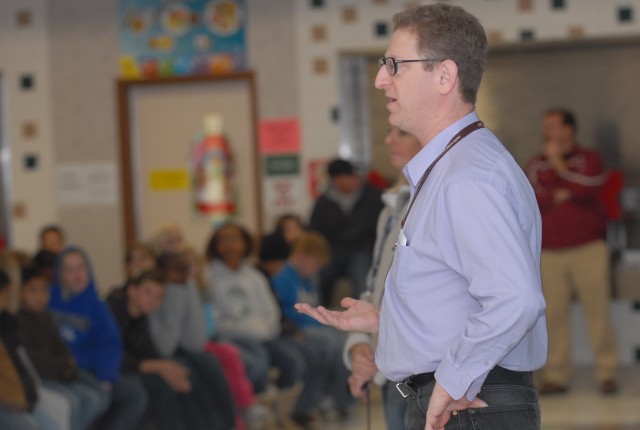FORT IRWIN, Calif.- Students at Tiefort View Intermediate School might not have drops of Jupiter in their hair, but they will definitely have their eyes on the Gaseous Planet as NASA prepares to launch its JUNO mission in 2011.
The spacecraft, which won't reach Jupiter until 2016, is just the latest example of how the Goldstone Apple Valley Radio Telescope (GAVRT) project is inspiring students at Fort Irwin to reach for the stars and learn more about science.
On Friday morning, fourth and fifth-grade students at TVIS heard first-hand how the work they're doing in the school's GAVRT science lab is helping scientists like Steve Levin, a project scientist for the JUNO mission, prepare for the mission, which is aimed at helping scientists gain a better understanding of the creation of planets and Jupiter itself.
"The data you are collecting on Jupiter is going to help us do our job," Levin told the students as he outlined the JUNO mission and explained the challenges associated with the mission.
Because Jupiter is the largest planet in the solar system, scientists are hoping to learn how it was formed, so they can better understand how other planets are formed, he said.
Additionally, questions remain about Jupiter itself, including if it has a solid core, how large the storms that form the planet's red eye are, as well as why the planet orbits faster than the earth despite its size, which the JUNO mission could answer, he told the students.
When TVIS principal Ruth Williams, who has championed the effort to bring the GAVRT program to her school, asked Levin, why Jupiter was chosen, Levin responded that one of the primary reasons is because the planet has more matter than all of the other planets combined.
"One of the things you have to ask yourself as a scientist is, 'What do I know'' and 'What do I want to know that I don't know now''" Levin said, adding that the next step in the quest is figuring out ways to find the information.
The JUNO mission isn't the first time students at TVIS have helped NASA through the GAVRT program, fourth-grade teacher Kristen Scarberry said.
"This year they helped with the Lunar Crater Observation and Sensing Satellite (LCROSS) mission and were able to help track it," Scarberry said of the lunar probe, which created a crater in the Earth's moon to help scientists learn more about the moon's composition.
During the LCROSS mission, students had to record their data and if there was data that appeared off the mark, students had to ask questions and attempt to explain the discrepancy, she said.
"It's great because it helps them feel connected to the school and the community," Scarberry said. "I've already had students from last year tell me they want to do it again."
While Scarberry has been working with the GAVRT program for the past year, fellow fourth-grade teacher Danica Paz is just becoming acquainted with the program for her students in her first year teaching at the school.
"I think it's great, because it gets the kids excited about science," Paz said, noting how the program reaches across the curriculum into math, reading and writing as well.




Social Sharing